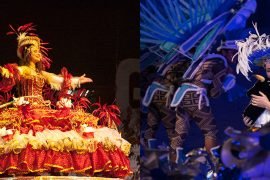Day of the Dead (Día de Los Muertos), celebrated on November 2nd, is one of the most traditional Mexican parties. Its origin dates back to pre-Hispanic period, when the Maya and Mexicas already celebrated the dead with rituals using conserved skulls from their deceased ancestors. The festivity has been declared as Intangible Culture Heritage of Humanity by Unesco, and is a time to honor the life of those who are not here anymore, although it is not necessarily a sad moment. In fact, it is fun and there is even singing.
Day of the Dead

One ritual that still takes place is the decoration of shrines, which can be inside the homes or in public spaces, like museums and cemeteries.


I visited two shrines, both in Guadalajara: the first one in the museum, for a recent deceased teacher. The other one was in the public library, in special honor to Mexican writers, like Carlos Fuentes.


Another element of Day of the Dead is Catrina, a flashy woman-shaped skull. It was created over a hundred years ago from Jose Guadalupe Posada´s character, and then reissued by Diego Rivera. Catrina holds many meanings, including death and the joy of living, being playful and seductive most times. Catrina is so adored and important in Mexican culture that it has become a colloquialism: when we want to say that a woman is very beautiful, we say she is Catrina, or Catrin!
Day of the Dead (Nov 2nd), Mexico
There are celebrations in several Mexican states. In Guadalajara (Jalisco), the celebrations include praying, musical performances and decoration of shrines. Panteón De Belén (a cemetery converted into a museum) is among the most visited ones – 684 Belén St. on the corner of Eulogio Parra, Col. Centro).
The website Cultura Guadalajara provides the complete schedule of the Day of the Dead celebrations in Guadalajara.
Translated by Lúcia Maciel
English teacher
© All rights reserved. Pictures and report 100% originals.









